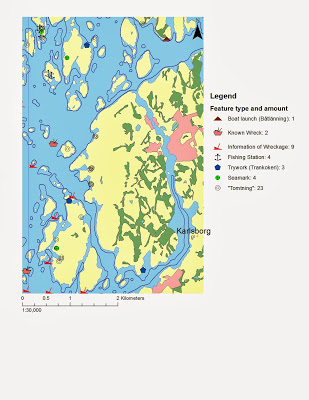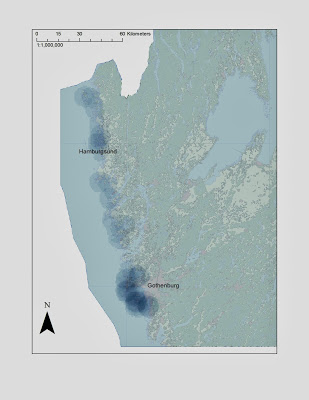Medieval History



FURTHER READING (Sorry, most of it's in Swedish)
- Cod Skulls Reveal Fishing Patterns In The Middle Ages
Scholars from the University of Cambridge have concluded that sea fishing in northwest Europe was more locally-based than previously believed. By using skulls of cod fish, the Medieval Origins of Commercial Sea Fishing Project was able to determine that...
- Researchers Look To Ancient Art To Study Mediterranean Fish
The dusky grouper has been a popular target for Mediterranean fishermen since prehistoric times ? their bones have been found in human settlements dating back more than 100,000 years. It?s a slow growing, flavourful and, with the advent of modern sport...
- Those Old Grey Stones Aren't What They Used To Be
On a promontory of land outside of the Swedish fishing town of Kaseberga, stand two rows of standing stones. A boat shaped burial monument, 220 feet (67m) long and composed of 59 megaliths that stand like sentinels guarding the cliffs and the pounding...
- Medieval BohuslÄn: On The History Of Place Names
ON THE HISTORY OF PLACE NAMES My previous posts (part 1 and 2) have been concerned with a castle ruin called Karlsborg, to the south of Hamburgsund. I have tried to put this rather unexplored ruin into a historical and economic context. More...
- A Visit To A 17th Century Village Part.2: Homesteads And Outfields
Today we are going to investigate the village of Stjärnholm once again, this time focusing on the homesteads themselves and the information we can find about them in Notarum explication. For more about this village, please read my earlier post! The...
Medieval History
Karlsborg: A castle by the sea pt.2
KARLSBORG: A castle by the sea pt.2
Some thoughts on Seasonal Fishing
In my last post, I introduced the ruin of Karlsborg castle, just south of modern day Hamburgsund. We explored the archaeological features of this castle, mainly through LIDAR data, and did a summary of what historical sources can tell us about this place. It seems like this was an important location, at least in the late middle ages and the early renaissance. Both Swedish and Danish kings obviously had an interest in controlling the area, and Karlsborg castle.
In this post, I am going to discuss the role that seasonal fishing might have played in defining the importance of this region. Using data from FMIS (Fornminnesregistret = lit. the register of ancient memories (ancient monuments)), we will explore what traces this activity left in the landscape.
Bohuslän have, at least in more recent centuries, long been associated with the fishing industry. The herring periods brought economic development to this otherwise quite marginalized area. Historical sources indicate that the fishing of herring was common already in the 11th century, and from Vestlandet (Western Norway) and Viken (the earlier name for Bohuslän) herring was exported to Germany and England in the late 12th century. However, it was not until the late 16th century that this fishing reached larger and more important proportions. From the middle of this century, fishermen from other parts of Denmark (which then included Norway) came to the coast of Bohuslän, establishing seasonal fishing settlements where they stayed from autumn till late winter. The large amount of herring that were drawn to Bohuslän during this period also attracted fishermen from abroad, both from the Baltic area and from North-western Europe. The city of Marstrand, located just north of Gothenburg, became a centre for international herring trade. Permanent coastal fishing stations were also established during the late 16th century, marking a change in habitation from earlier centuries. The herring period of the 16th century lasted for 40 years, after which the activity in the area ceases quite abruptly.

Picture showing some typical examples of what a "tomtning" might look like. Photo from: Bohusläns Museum.
The type of seasonal fishing settlements discussed above are called ?tomtningar? (singular = ?tomtning?) in Swedish. These are features usually found in connection to beaches of different kinds, identified by a low stone wall enclosing a space usually about 1-10 meters wide. While there are some inland examples, almost all tomtningarare located on islands. The geometrical shape of a tomtningmay vary from circular to quadratic. It is not unusual that several of these features lie side by side, like a row house. Archaeological investigations have shown that tomtningar usually can be dated to a period between the 13th - 16th centuries. Investigations on Söö island, south-west of Gothenburg, have also shown that bones from cows and sheep are commonly found in these features, indicating that fish were considered important trade goods, and not meant for personal sustenance. In addition, English coins dating to the 13thcentury have been found in tomtningar on Söö island, indicating the presence of international fishermen.

A map created in ArcGIS showing remains in the area related to the sea and fishing. You will see this map again in coming posts, but for now we are mainly concerned with "tomtningar". Click for larger picture.
We can see, in the map, that there are 23 tomtningar on the islands outside Karlsborg. From the above material, we can assume that at least some of these are from the active period of the castle. But does this really give us a clue to the importance of this region? Why would Kings care about this?
According to medieval law, all local inhabitants had the right to use the beach for their boats, nets and to bring up the catch. But the King owned all land defined as ?Forstrand? (foremost beach?). What is meant by this is somewhat unclear, though a common interpretation is that the king owned a part of the beach, and presumably all islands without a farming population. The King would then be the only person with the right to allow fishermen from other parts of the kingdom and abroad to use these islands and beaches for seasonal fishing. We can also assume that this would give him the opportunity to collect tax from these fishermen, thus increasing his revenues and giving him control of international trade.

A Point Density analysis done in ArcGIS showing the geographically dense areas of "tomtningar" in the County of Västra Götaland. Click for larger picture.
The Point Density Analysis of Tomtningar in the county of Västra Götaland shows that the area just north of Hamburgsund is an area with a large amount of tomtningar, an amount only bested by denser concentrations in the archipelago outside of Gothenburg. While tomtningarin the area of Gothenburg have been the focus of some research, the concentration found to the north of Hamburgsund and to the west of present day Fjällbacka, have been largely ignored. In my opinion, this concentration, in relation to the political history of the area, can provide a plausible explanation for the importance of Karlsborg.
This, however, must be explored on a deeper level, especially as we cannot give a definite dating for these seasonal fishing settlements. Given the archaeological investigations in other areas, we can presume, but not of course be entirely sure. We have to delve deeper into the historical and geographical characteristics of this area, in order to see what other features that define the region. For this, see my upcoming posts!
Till then, I would very much appreciate my readers insight and ideas. Here are some questions I would like to raise:
- What do you think of the above theory?
- Would the prospect of economic revenues be enough motivation for controlling this specific area?
- Why were the islands north of Hamburgsund, as compared to other areas in Bohuslän, so dense in seasonal fishing?
Ersgård, L. (2001). Människan vid kusten ? fiskebebyggelse från Skagerack till Bottenhavet under senmedeltid och början av nyare tid. In Andrén, A., Ersgård, L. & Wienberg, J. (ed.) (2001). Från Stad Till Land: En medeltidsarkeologisk resa tillägnad Hans Andersson. Almqvist &Wiksell Internation: Stockholm.
Svedberg, V. & Jonsson, L. (2006). Medeltida urbanisering och fiske i Västsverige. Göteborgs universitet: Nossebro.
Stibéus, M. (1997). Medieval Coastal Settlement in Western Sweden. In Andersson, H, Carelli, P. & Ersgård, L. (ed). Visions of the Past: Trends and Traditions in Swedish Medieval Archaeology. Lund Studies in Medieval Archaeology 19. Riksantikvarieämbetet, Arkeologiska Undersökningar, Skrifter nr 24. Lund.
Stibéus, M. (2004). Medeltida Tomtningar På Söö. UV Väst rapport 2004: 35
Link to this report, here
- Cod Skulls Reveal Fishing Patterns In The Middle Ages
Scholars from the University of Cambridge have concluded that sea fishing in northwest Europe was more locally-based than previously believed. By using skulls of cod fish, the Medieval Origins of Commercial Sea Fishing Project was able to determine that...
- Researchers Look To Ancient Art To Study Mediterranean Fish
The dusky grouper has been a popular target for Mediterranean fishermen since prehistoric times ? their bones have been found in human settlements dating back more than 100,000 years. It?s a slow growing, flavourful and, with the advent of modern sport...
- Those Old Grey Stones Aren't What They Used To Be
On a promontory of land outside of the Swedish fishing town of Kaseberga, stand two rows of standing stones. A boat shaped burial monument, 220 feet (67m) long and composed of 59 megaliths that stand like sentinels guarding the cliffs and the pounding...
- Medieval BohuslÄn: On The History Of Place Names
ON THE HISTORY OF PLACE NAMES My previous posts (part 1 and 2) have been concerned with a castle ruin called Karlsborg, to the south of Hamburgsund. I have tried to put this rather unexplored ruin into a historical and economic context. More...
- A Visit To A 17th Century Village Part.2: Homesteads And Outfields
Today we are going to investigate the village of Stjärnholm once again, this time focusing on the homesteads themselves and the information we can find about them in Notarum explication. For more about this village, please read my earlier post! The...
